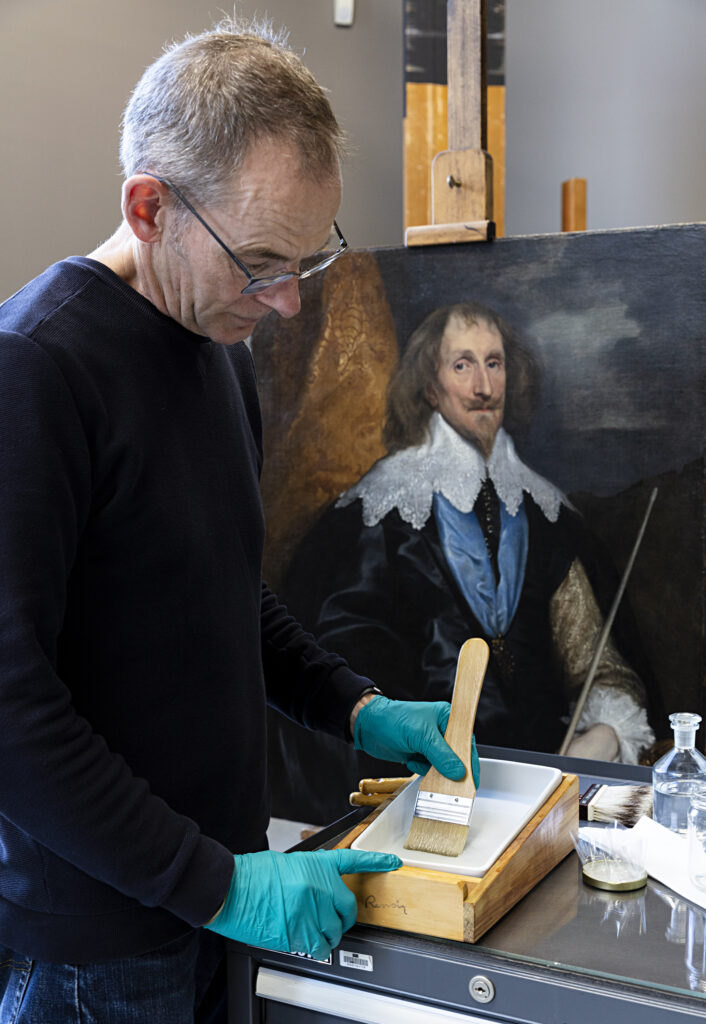Those who had stocked up used the precious liquid sparingly, dreading the day it ran out. Others desperately tried alternative resins, which weren’t good enough. It was the end of high-quality conservation grade resin.
Then one day, Carl Villis, Senior Painting Conservator at the National Gallery of Victoria (NGV), called the CSIRO and the rest is history.
The art of conservation
As the name suggests, art conservation is all about preservation.
“It’s about … keeping it intact not just so that it survives but so that it is able to be viewed in a [way] that’s best suited for the artwork,” says Carl.
This is often easier said than done.
According to David Graves, Object Conservator at the Art Gallery of WA, there are four main areas of art conservation in Australia: paper; painting; textiles; and objects – which covers just about everything else.
“I deal with pretty much everything that isn’t either a painting or a work on paper,” says David.
“Quite often it’s a very labour-intensive job. The treatments are normally done in months rather than in weeks. Some exceptional paintings are done in years instead of months,” says Carl.
Keeping the receipts
When an institution like the NGV or Art Gallery of Western Australia gets a piece of artwork, they analyse it to see if it needs any sort of treatment.
Ideally, the artwork would come with thorough background information, but those records are often missing or incomplete.
“Quite often, there’ll be other materials in there [the artwork] that haven’t been recorded or they’ll use a trade name for something,” says David.
Missing documentation can leave critical questions unanswered, prompting a deeper analysis – where things get real scientific.
In Australia, most of this detective work is performed in-house by the fully qualified conservators, who all have a science degree.
“We do some UV work, X-ray fluorescence, FTIR and all sorts of other things to analyse the materials,” says David.
According to Carl, a painting is “a very complex agglomeration of many different components.”
A conservator may need to analyse everything from the canvas stretcher to tiny paint samples to identify and document the materials used in a painting.
“Sometimes you’re doing quite irretrievable things such as removing a varnish. You can’t go ahead and do that unless you have absolute full knowledge of what’s there. And what you expect to see as the treatment unfolds,” says Carl
After the treatment process has been planned out, approved and completed, “everybody comes in and has a look and determines whether it’s acceptable and then it’ll go up on display.”
“And hopefully we won’t have to touch it again for another 100 years or so.”
Let’s get physical
The physical environment has a big influence on how long an artwork lasts.
Typically, conservators try to control three things: temperature, relative humidity and light.
For temperature and relative humidity, stability is key. For maximum longevity, artworks shouldn’t experience big fluctuations over a short period of time.
For paintings, changes in relative humidity make the canvas or the panel structure holding it expand or contract.
“If that happens a lot, it has a wearing effect on the microstructure of the artwork,” says Carl.
For objects, the baseline is around 50% humidity and 21°C, which is adjusted according to the material used to make the artwork.
“If you want to keep a purely metal object preserved, you want to keep it bone dry. If you can keep that below 10% humidity, then you’re not going to get any corrosion,” says David.
“However, if you do that to an organic material, it’s going to cause all sorts of problems because it will dry out, crack and split.”
The other critical thing to control is light.
“Just like how it will burn our skin, it will also have a bad effect on the surface of a painting,” says Carl.
“It initiates the degradation reactions that cause the paint to break down and cause the varnish to go brown.”
“If you can keep the varnish of a painting from exposure to UV lights, it can extend the life of the varnish by many decades.”
So, what’s the big deal with varnish?
“Varnishes are critically important for painting conservators because they can be critical to the success or the failure of an artwork … both in terms of its appearance and longevity,” says Carl.
Apart from providing a layer of protection for the original paint surface, varnish also controls the level of gloss, texture and saturation in a painting.
“A good varnish will make it easier for you to get the effect you’re after,” says Carl.
“If it’s done badly, it can ruin all the good work you’ve put into a conservation treatment. That’s why it’s so important that we have good varnishes available to us.”
And thanks to that phone call between Carl and the CSIRO, a brand new resin called MS3 was created – allowing art conservators around the world to breathe a collective sigh of relief.













